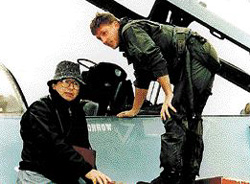Critical system had history of failure

|
10 outstanding maintenance directives
The story so far: Lt. Cmdr. Randall E. McNally had a storybook life. Navy Reserve pilot. Stanford Law School graduate. Aspiring novelist. Engaged to be married. Then he climbed into the cockpit of an A-6E Intruder jet on April 5, 1994, and everything changed.
By Russell Carollo
Dayton Daily News
The A-6E Intruder Navy Lt. Cmdr. Randall E. McNally II flew on April 5, 1994, like the other A-6Es in Attack Squadron 304, was to be mothballed sometime before October of that year. The Navy, responding to cutbacks mandated by Congress, had decided to decommission about a half-dozen squadrons making up Reserve Carrier Air Group 30.
|
'The A-6s had a history of wing cracks that were discovered years ago.' -- Lt. Cmdr. Aladar Nesser
|
The A-6, first used in 1963, was the Navy's only medium-range bomber, but its maximum speed is was only about 650 mph, making it more and more vulnerable to increasingly sophisticated antiaircraft weapons. By 1997, the Navy decommissioned all A-6s.
At the time of McNally's crash in 1994, the maintenance shop responsible for repairing the aging A-6s in Attack Squadron 304 was shorthanded and under pressure. Records from the Naval Safety Center described the shop this way:
"Undermanned and decreasing department was supporting a challenging operational schedule which included frequent fleet support detachments but was performing at an outstanding level."
The records also show managers were carefully monitoring the shop because it was operating at "decreasing levels." Still, the records say, the mechanics were well-trained, and commanders believed that "safe maintenance was being done."
Records from the Naval Safety Center show that following a test flight on March 28, 1994, eight days before the crash, mechanics reported problems with the jet's stabilizer augmentor. The electronic device helps the pilot operate the moveable control surfaces on the wings and tail -- parts critical to the operation of the aircraft.
Trying to control a jet without a stabilizer augmentor is similar to trying to steer a car when the power steering fails.
"It could affect the movement of the aircraft," said Don Delk, an Air Force jet mechanic for 22 years. "To me, that would be a very important part of the investigation."
Mechanics suspected the problem with the stabilizer augmentor was caused by the Air Navigation Computer, which operates constantly on the aircraft and feeds information to aircraft systems such as the autopilot and bombing systems.
That computer, Navy investigators reported, had a "high failure rate." Investigators noted that during the A-6E's previous 14.7 hours of flight time, the Air Navigation Computer was changed twice, at least once by cannibalizing a computer from another plane.
At the time of the crash, McNally's plane had flown 5.1 hours since the test flight in which mechanics found problems with the stabilizer augmentor.
 MCNALLY FAMILY PHOTO
MCNALLY FAMILY PHOTOMCNALLY (CENTER) AND his brothers Edward (left) and Patrick were photographed on Chicago's Michigan Avenue during the '81 Christmas season. |
"That's a mechanical piece that wasn't recovered that remains a possibility," Lt. Cmdr. Nesser said. "The stabilizer augmentor system was looked over as a possible cause."
Naval Safety Center records also show that at the time of the crash, McNally's A-6E had at least 10 outstanding technical directives mandating maintenance work on the plane. Additional records from an accident report show the aircraft had 18 outstanding directives, 12 of them identified as "urgent."
No aircraft identified in the Navy Safety Center's accident database had more outstanding technical directives.
Several of the directives on McNally's jet mandated repairs on wing parts, and at least five of those directives noted "fatigue cracks" on the wings.
"The A-6s had a history of wing cracks that were discovered years ago," Nesser said, adding that the cracks prompted the Navy to restrict the planes from performing certain maneuvers that put heavy stress on the wings.
McNally's A-6E was one of the planes restricted from flying certain maneuvers.
Investigators suspect metal linked to deadly crashes
Questions were raised about parts made at Springfield factory.
 MCNALLY FAMILY PHOTO
LT. CMDR. RANDALL E. MCNALLY II and his father, Dr. Randall E. McNally, are shown outside an A-6 Intruder at Glenview Naval Air Station in Illinois.
MCNALLY FAMILY PHOTO
LT. CMDR. RANDALL E. MCNALLY II and his father, Dr. Randall E. McNally, are shown outside an A-6 Intruder at Glenview Naval Air Station in Illinois.